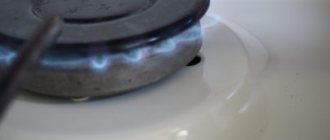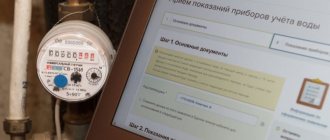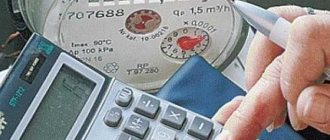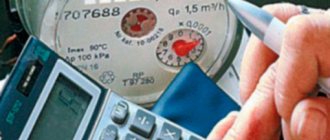Law No. 261, adopted on November 23, 2009, states that the installation of a gas meter is a mandatory requirement. Control devices had to be put into operation before 2015, but adjustments in 2014 abolished the norm for apartment owners if they do not have personal heating.
No one is stopping the homeowner from installing control equipment. Installing the device allows you to reduce gas payments, since the calculation of the receipt without a meter is based on a weighted average value.
Why is there a gas meter in the apartment?
Before answering whether your apartment needs a gas meter, we suggest you figure out what this device is used for.
Natural gas is an energy resource used by citizens for domestic purposes for:
- cooking;
- water heating;
- space heating.
Gas is provided to citizens on a paid basis under agreements concluded between home owners and the supplier - regional representative offices of Gazprom.
Payment is made according to uniform tariffs for the population. The amount is calculated taking into account the volume of energy resources used by a specific consumer. Such data can only be obtained using a special accounting device installed and put into operation in accordance with current legislation.
When it comes to natural gas, a gas meter is used to record the volume of fuel consumed.
At first glance, it may seem that all natural gas consumers must install gas meters in their apartments. Until recently, most consumers of “blue fuel” actually had this responsibility. However, given the insignificance of consumption by individual users and the high cost of equipping housing with meters, the legislator has provided exceptions to the general rule.
Who can install a gas meter
Those who believe that only a Gazprom representative can install a gas meter are wrong. Today, many specialized installation organizations are engaged in installing gas meters, and they do it very well, and most importantly carefully. Moreover, to install the meter using Gazprom’s efforts, you will have to run around a lot and spend a lot of invaluable personal time.
By the way, many of the demands of gas workers for installing meters are unfounded, for example, obtaining technical specifications or preparing a project. There is positive judicial practice in favor of consumers on the illegality of imposing these services.
In any case, unauthorized installation of gas meters is prohibited, and such gas meters cannot be put into operation. We also do not recommend turning to private craftsmen from stores selling gas equipment in order to save your own money. Such “savings” when putting a gas meter into operation can result in wasted nerves and loss of money on installing the meter.
Today, almost all entrances are papered with advertisements offering to install gas meters. Often only a mobile number is indicated as a contact phone number. People, be careful! There are more and more people who want to take your money. When choosing an installation company, pay attention to how long it has been in business and what reviews it has. Compare and choose.
If it turns out that installing the meter will require welding work, we recommend contacting a service organization, since during the work it will be necessary to turn off and restart the gas not only in your apartment, but also in the entire entrance. It is better not to risk your own safety here. In any case, request that an agreement be drawn up with the installation company for the installation of a gas meter. It's calmer this way.
Do you need a meter in an apartment: legal norms
To find out whether it is mandatory to install a gas meter in an apartment in 2020, let’s look at the legislation. Previously, its norms obliged all homeowners using natural gas for domestic purposes to equip their homes with metering devices by 01/01/2015. However, the changes made to Art. 13 (hereinafter referred to as Federal Law No. 261), provide for a number of exceptions to this rule.
According to the new requirements, only owners of households whose natural gas consumption exceeds 2 m3/h are required to install a meter. Approximately this volume is used when cooking on gas stoves. Combinations of gas appliances, for example, stove + gas water heater, exceed the specified consumption volume.
In 2020, the legislation on the installation of a gas meter has undergone further changes. After amendments to , the requirement to install metering devices does not apply to homeowners whose residential premises are not equipped with natural gas heating equipment.
Owners of housing that use several gas appliances are not required to install meters, even if the consumption volume is above 2 m3/h.
But since the law does not deprive them of the right to use a meter, it is important to understand whether it is profitable to install a gas meter in an apartment with a water heater. To answer this question you need:
- Calculate equipment and installation costs.
- Compare them with current gas costs (consumption standards taking into account the number of registered residents).
- Calculate the payback period for the meter.
Homeowners whose homes are equipped with individual gas heating equipment do not have such a choice. All of them are required to equip their homes with metering devices by the beginning of 2020.
Benefits from installing a gas meter
With rising gas tariffs, more and more people are thinking about installing a gas meter. In addition, the standard gas consumption for the population for cooking and heating hot water is determined on an average basis, that is, it does not reflect the real picture of gas consumption in each specific case. Therefore, subscribers lack any motivation to save gas fuel.
How to determine the economic benefit of installing a meter?
The more residents are registered in the apartment, the more profitable it becomes to install a gas meter. The average payback period for installing a meter at the current level of gas tariffs ranges from one to three years. But immediately there is a feeling of fairness of the calculations and a motivated desire to save gas.
Moreover, many people use electric kettles, microwave ovens, multicookers, etc. Consequently, the gas consumption will be even less. An average family of 3 people pays 290 rubles/month for gas for cooking. After installing a gas meter, the same family pays for the gas consumed by the meter in the amount of 50-60 rubles. per month. The benefits of installing a gas flow meter are obvious.
Selecting a meter
It's time to discuss how to choose household meters for metering gas consumption. Let's take two main criteria as a basis: throughput and meter type.
Bandwidth is the main parameter when choosing a model. It depends on the number and power of installed gas appliances. This parameter is always indicated in the meter labeling under the letter “G”. For example, in the “Gazdevice NPM G-4” meter the throughput parameter G is 4, and in the “SGBM G1.6” meter G is 1.6.
Let's look at the main types of throughput meters in table form.
| Bandwidth | Lower gas flow range in m3/h | Upper gas flow range in m3/h |
| G 1.6 | 0.016 | 2.5 |
| G 2.5 | 0.025 | 4 |
| G 4 | 0.04 | 6 |
| G 6 | 0.06 | 8 |
| G 8 | 0.08 | 10 |
| G 10 | 0.1 | 16 |
| G 16 | 0.16 | 25 |
To determine which gas meter is best for the stove, you need to know its flow range. It is usually indicated in the technical documentation. For example, if the range is min 0.015 m3/hour; max 1.2 m3/hour, a meter with a capacity of G 1.6 is sufficient.
In a room with several devices, to calculate the throughput, the minimum value of the lowest flow of them, which is usually the stove, is taken into account, as well as the sum of the maximum values. For example:
- gas stove: min 0.02 m3/hour; max 1.2 m3/hour;
- geyser: min 1.06 m3/hour; max 2.4 m3/hour.
This means that the minimum consumption will be 0.02 m3/hour, and the maximum - 3.6 m3/hour.
There are no meters with this range. But if the device does not fit only the minimum value with a difference of 0.005 m3/hour, regional suppliers allow its installation, taking the difference as their own losses. Thus, for our example, a meter with a capacity of G 4 is suitable.
If the difference exceeds 0.005 m3/hour, the consumer will have to install 2 meters, creating a separate personal account for each.
The second criterion is the type of metering device. Let's consider their advantages and disadvantages.
There are three types of meters on the market:
- A rotary or mechanical gas meter for an apartment is compact and low in price ($25-110), but at the same time it has a high error, short service life, is sensitive to dirt and is noisy during operation.
- The diaphragm (membrane) device has a simple, reliable and stain-resistant design, which ensures its durability (up to 30 years of operation) and low cost (up to $100). At the same time, it has large dimensions and is characterized by increased noise.
- Electronic: the most reliable, accurate and silent metering device. The size of the gas meter will also pleasantly surprise you, but it costs more than its analogues (up to $200).
Installation of a natural gas meter
If the consumer wants or is required by law to install a meter in the apartment, he must adhere to the following procedure:
- Calculate the required gas meter capacity yourself or get advice from a gas distribution or specialized organization.
- Purchase a meter with the appropriate power.
- Call a specialist for installation.
- Put the meter into operation by sealing it.
- After the specified period, check the meter.
To give a comprehensive answer to the question of how to properly install a gas meter in an apartment, we will consider in more detail all stages of the process.
Who does the installation
Citizens have no right to interfere with the operation of gas distribution systems. In accordance with clause 5.5.2 dated September 27, 2003, installation, dismantling and installation of any gas appliances can only be carried out by specialized enterprises. According to May 14, 2013, such organizations are either the distribution companies themselves or accredited companies that have entered into an agreement with the gas supplier.
Citizens wishing to install a meter must contact the customer service of a local branch or another accredited organization. Contacting a gas distribution company will significantly speed up the procedure and eliminate unnecessary hassle. You can also submit an application through the Single Window service.
Package of necessary documents
In order to install a gas meter, the homeowner must enter into a maintenance agreement with the gas distribution company for in-house gas equipment.
After signing the contract, in accordance with 04/07/2010, the subscriber contacts the competent organization with an application to install a meter. We recommend that you familiarize yourself with the application form in advance.
The application should be accompanied by:
- homeowner's passport;
- a document confirming the applicant’s ownership of the residential premises (extract from the Unified State Register of Real Estate / certificate of registration of ownership);
- a copy of the house register or an extract from a personal account;
- registration certificate for the apartment;
- technical documentation for gas equipment installed in the premises (for calculating throughput);
- maintenance agreement;
- registration certificate for the meter;
- a certificate of no debt for consumed natural gas.
In some cases, changes to design documentation are required.
After agreeing on the installation and receiving confirmation, the subscriber contacts the district operational service with an application for installation work.
Details regarding the application and submission of documents can be found in the publication “Agreement for servicing gas equipment”.
Gas meter installation
At the appointed time, employees of the operational service or a specialized organization will arrive at the address specified in the application. The owner is obliged to provide them with access to the installation site.
Workers installing a gas meter must be certified and have certificates confirming their training and qualifications.
If installation is carried out by representatives of a specialized enterprise, an employee of the gas distribution company must be present during assembly. This issue must be agreed upon in advance.
Installation rules
Installation of a gas meter is carried out taking into account the Technical Instructions, approved. dated 02/13/1969. In accordance with them, natural gas meters are installed according to the following rules:
- the meter is mounted on a main wall at a height of 160 cm from the floor to the bottom of the device;
- the horizontal distance from the edge of the meter to the nearest gas burner must be at least 80 cm;
- It is unacceptable to install a gas meter in a living room, hallway, landing, bathroom or bathroom;
- household consumers must place the meter in a ventilated room in which gas equipment is concentrated, that is, in the kitchen;
- gas pipes connected to the meter must be parallel to each other and in the same plane.
Putting the meter into operation
After installation, the meter should be put into operation. This does not happen during installation, but during sealing.
For normal operation and accurate measurement of the volume of gas used, in accordance with clause 25 of the Rules, approved. dated July 21, 2008, apartment meters must have:
- working condition;
- unbroken seals installed by the manufacturer and secured at the points where the meter is connected to the gas pipeline;
- confirmation of verification if the deadline for passing the next control has not yet arrived.
Thus, for proper operation, the meter must be sealed and tested.
Counter sealing
The procedure for sealing the device allows you to prevent unauthorized interference in the operation of the metering device.
In accordance with paragraphs. b) clause 22 of the Rules, approved. According to Government Decree No. 549, regardless of who installed the meter, sealing is carried out by a representative of the supplier -.
If the meter was installed by the supplier company, sealing is carried out simultaneously with installation. If the installation was carried out by a specialized organization, you need to call a representative of the supplier for sealing.
Before sealing the device, a representative of the gas distribution company will check the correct installation of the metering device, and then install a seal at the point where the meter connects to the gas pipeline.
The device must be sealed no later than 5 days from the date of receipt of the application. Primary sealing is free of charge.
Meter verification
According to paragraphs. c) clause 21 of the Rules, approved. Government Decree No. 549 obliges the consumer to submit the meter for verification within the established time frame. The need for periodic verification of measuring instruments during their operation is also established by the Procedure, approved. .
The period for the next inspection is calculated not from the moment of its installation, but from the date of the initial inspection. This date and the inspection interval (the period until the next inspection) are indicated in the technical data sheet of the device.

After this period, the meter may show incorrect data, so it cannot be used to account for gas consumption. The subscriber must promptly submit the meter for verification. To do this you need:
- Contact the organization with which he entered into an agreement for the maintenance of gas equipment.
- Provide a representative of the organization with access to the meter for dismantling.
- Deliver the meter yourself for inspection to the agreed address.
- Receive a certificate of verification.
- Call a specialist to reinstall the meter and seal it.
Rules for installing a gas meter
For gas meters, the manufacturer may have different installation requirements. It is better to familiarize yourself with them before purchasing.
For example, the instructions for some meters indicate the permissible distances from it to other gas appliances. As a rule, this is 80 cm. Not in all kitchens, especially in Khrushchev and Brezhnevkas, it is possible to place a gas meter in compliance with these requirements. At the same time, there are meters, for example, GRAND or SGMB, for which the specified distances may not be maintained.
The gas meter is installed at a height of 1.6 m from the floor, that is, during installation it is possible to provide for the possibility of hiding it in a wall cabinet in the future. It is also prohibited to install a gas meter above a sink or closer than 50 cm from electrical wiring.
Don’t forget to check that the installation company has made a note in the meter’s passport about its installation.
Commissioning of a gas meter
After installation of the gas meter is completed, it is subject to acceptance and sealing by a representative of the gas supply organization. Meter sealing is free of charge and is carried out upon written request from the subscriber within 5 days.
The only legal basis for refusal to seal may be identified violations of the rules for installing a gas meter. Upon acceptance, a certificate of admission of the metering device into operation is issued.
The final stage is a trip to the gas supply organization to conclude a contract for gas supply using a meter. To do this, take with you a personal passport, a passport for the meter, passports for all gas equipment installed in the apartment (stove, boiler, water heater), a certificate of ownership, the latest receipts for payment for gas to confirm the absence of debt, a copy of the contract for maintenance of the apartment gas equipment.
After concluding a gas supply agreement, you will receive receipts with completely different amounts. All you have to do is monitor compliance with the deadline for checking your gas meter, and when this deadline approaches, think about what will be cheaper - remove it, check it, put the meter back in place, or replace it with a new gas meter.
Make the right choice. We hope this article was useful to you.
We also recommend watching
Installation of gas equipment and gas pipelines
Who pays for the installation work?
Unfortunately, it will not be possible to install a gas meter in your apartment for free. In accordance with Art. 13 Federal Law No. 261, the owner himself must equip his residential premises with metering devices. This approach is quite justified from the point of view of civil and housing legislation, because in accordance with Art. 210, it is the owner who bears the burden of maintaining his property.
At the same time, in accordance with Art. 158, the owner is obliged to bear the costs of maintaining the premises in an apartment building, which means that it is he who pays for the installation of the gas meter.
Cost of meter and installation
The regulations do not establish a specific cost for the meter including installation. The price range for meters alone is quite large, because their cost depends on the characteristics, manufacturer and country of origin and varies from $25 to $200.
The uniform cost of installation is also not fixed across the country. In accordance with paragraph 9 of Art. 13 Federal Law No. 261, installation is carried out on the basis of an agreement concluded between the consumer and a specialized organization. Each enterprise independently determines how much it costs to install a gas meter.
For example, in Astrakhan, in accordance with, a single cost is determined at 4.1 thousand rubles without the cost of the meter. At the same time, in Orenburg, according to , a single price has not been established.
The final cost of the procedure depends on the list of work performed and includes the price:
- preparation and execution of documents;
- installation of the meter (with or without welding);
- installation of a tap and flexible hose;
- cutting the gas pipeline and laying new pipes;
- gas restart and so on.
Thus, the final cost, depending on the installation method and the number of gas appliances, varies from 1994 to 5771 rubles. More specific data can be obtained on the website or at the representative office of your gas distribution company or maintenance organization.
Selecting a gas meter
Today there are a huge number of different models of household gas meters on sale, and as a result, it is very difficult for an ordinary person to make the right choice. You can, of course, turn to your acquaintances or friends for help, but it’s better to try to figure it out yourself.
The main thing is the throughput of the metering device. There are meters for 1.6 m3/h (only for a gas stove), 4 m3/h (for a stove and a column), 6 m3/h (a boiler, a stove and a column).
Different locations of the gas supply pipeline may require a right- or left-handed meter depending on the direction of gas flow.
If you purchase the meter yourself or entrust its purchase to installers, make sure that the date of its release is in the current year, so that the passport must contain a mark about the sale and information about the initial verification. The interval between verifications also varies - from 3 to 12 years. Meters are also available mechanical and with an electronic display, powered by lithium batteries.
When choosing a meter, it would be useful to ask in what position it is recommended to install it: on a horizontal section of the gas pipeline, vertically or in any position.
Of course, all of the above parameters affect the cost of the gas meter.
Equipment Maintenance
As mentioned above, a prerequisite for the supply of gas and installation of a metering device is the conclusion between the consumer and the supplier / specialized organization of an agreement for the maintenance of gas equipment.
Such equipment includes a gas pipeline connected to the gas distribution network, metering devices, as well as gas equipment itself: stoves, dispensers, boilers. The range of maintenance work is aimed at keeping the devices in good condition.
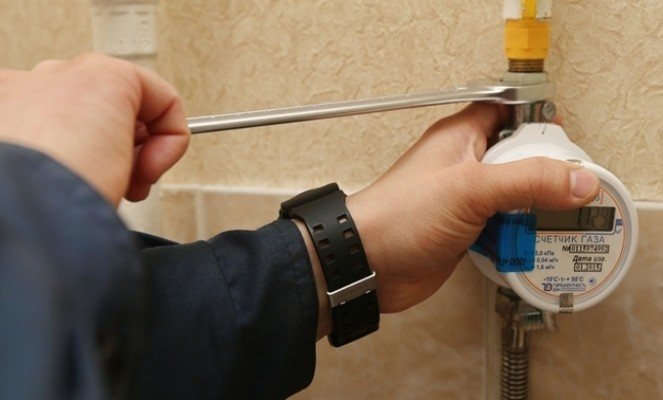
Maintenance work usually includes:
- visual inspection of the conditions of installation and use of gas equipment;
- control of tightness, integrity, completeness and operability of equipment;
- checking the presence of traction, disassembling and lubrication of valves;
- work on cleaning burners from contamination;
- analysis of the need to replace/repair individual parts of equipment;
- checking pressure, serviceability of automation, leak detection;
- registration of repair requests, adjustment of equipment, and so on.
In total, the list of works consists of more than two hundred items. In total, the list of works consists of more than two hundred items.
Read more about this in the material “Maintenance of gas equipment”.
Replacing the meter
If, as a result of the next verification, the meter is found unsuitable, the consumer receives a “Notice about the unsuitability of the meter.” The device can be repaired by the work contractor, except in cases where it cannot be repaired. In this case, the metering device is not allowed to be used. The consumer buys a new meter to install it in the manner described above.
The subscriber has the right not to verify the meter and repair the faulty one, but to immediately replace the device with a new one.
For those who are interested in the cost of replacement, we explain: re-installation is also paid for by the consumer. In addition, the subscriber pays not only the cost of the meter and installation work, but also re-sealing. The cost of installing a seal is 380-400 rubles.
